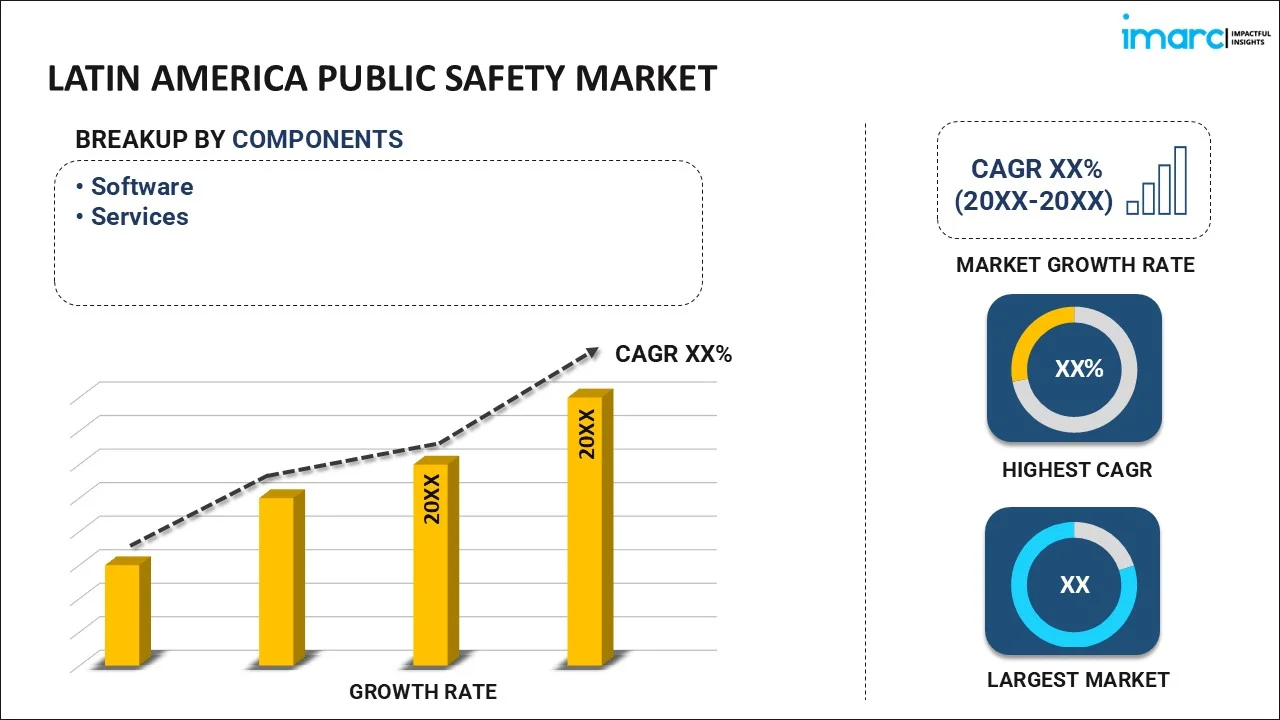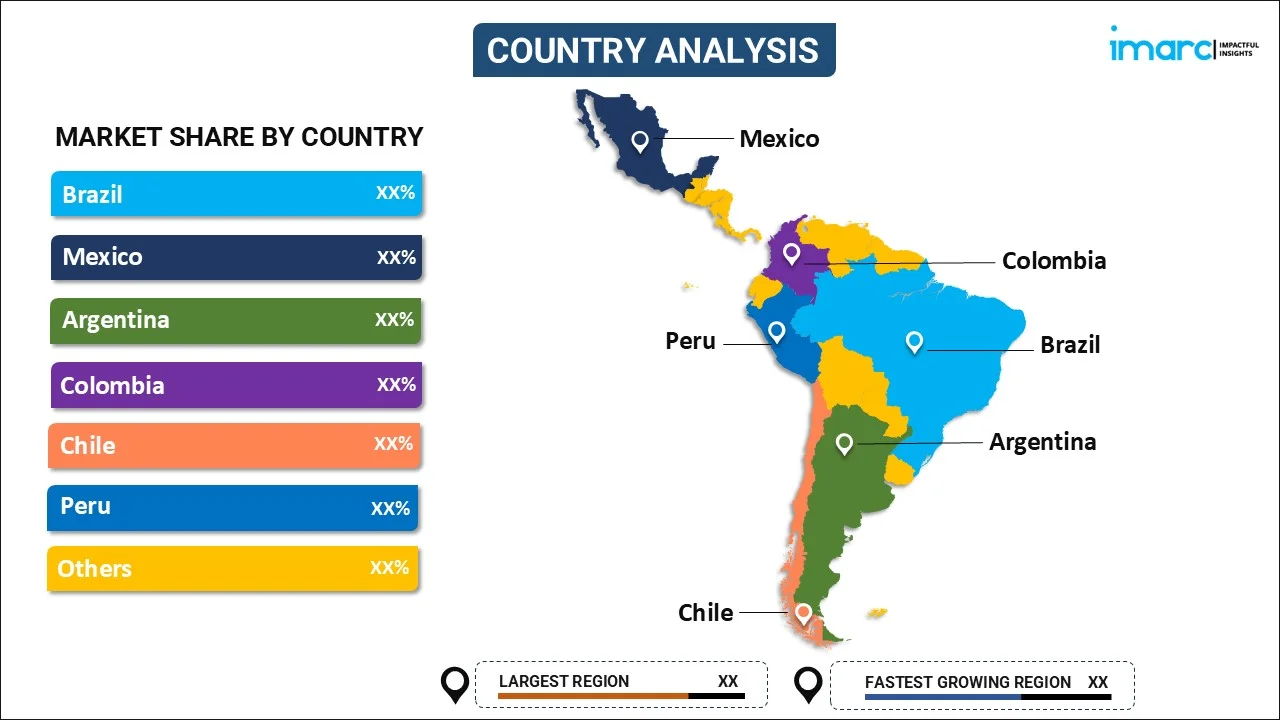
Latin America Public Safety Market Size, Share, Trends and Forecast by Component, Mode of Deployment, End-user Industry, and Country, 2025-2033
Latin America Public Safety Market Overview:
The Latin America public safety market size reached USD 30.66 Billion in 2024. Looking forward, IMARC Group expects the market to reach USD 69.39 Billion by 2033, exhibiting a growth rate (CAGR) of 8.80% during 2025-2033. The Latin American public security market is growing as a result of increasing investments in smart surveillance, cybersecurity, and emergency response systems. Further, governments are embracing AI-based security solutions while increasing urbanization and crime rates compel demand for advanced communication networks and real-time monitoring technologies to ensure improved safety measures.
|
Report Attribute
|
Key Statistics
|
|---|---|
|
Base Year
|
2024 |
|
Forecast Years
|
2025-2033
|
|
Historical Years
|
2019-2024
|
| Market Size in 2024 | USD 30.66 Billion |
| Market Forecast in 2033 | USD 69.39 Billion |
| Market Growth Rate (2025-2033) | 8.80% |
Latin America Public Safety Market Trends:
Increasing crime rates and security concerns
The constant increase in the crime rate among different nations of Latin America is leading to the growing demand for robust public safety systems. Higher levels of crime, such as violence and criminality, are compelling governments to invest in effective safety strategies. In addition to this, major investments in up-to-date surveillance systems, training for law enforcers, and community security initiatives are also emerging as priority areas to help deal with citizens' increasing demands for security. Along with this, the presence of advanced security solutions such as biometric systems, automated surveillance, and emergency communication networks are aiding authorities to tackle crime more effectively. This emphasis on controlling crime is further contributing to growing partnerships with private security companies and technology companies providing innovative solutions geared towards Latin America's unique needs. These measures are enhancing public confidence in security provisions and toward a safer overall environment.
Rising Urbanization and Population Density
Latin America is experiencing a consistent increase in urbanization, with major cities facing burgeoning growth and immigration. This is causing mounting public safety issues such as traffic volume, crime, and disaster response requirements. Also, the need for efficient public safety practices is growing in the region with more people moving to urban settings. Governments are reacting with investments in infrastructure capable of accommodating the safety of a more densely populated, larger population. This includes the enhancement of emergency response capabilities, expansion of public safety networks, and robust public transportation security systems, that are favoring the market. Population density is also encouraging local administrations to integrate more comprehensive safety solutions to manage risks associated with crowded urban centers, thereby fueling the growth of the public safety market.
Technological Advancements in Public Safety Solutions
The growth of advanced technology in Latin America's public safety sector is playing a significant role in enhancing the market. Governments and municipalities are incorporating state-of-the-art technologies such as artificial intelligence (AI), Big Data analytics, and the Internet of Things (IoT) for enhanced surveillance and response systems. These solutions improve real-time monitoring, predictive analytics, and data-driven decision-making, enabling faster responses to emergencies and better management of public safety operations, which is creating a positive market outlook. Cloud-based platforms are also being adopted for more efficient data sharing across departments and regions, ensuring comprehensive coordination during crisis management. Moreover, authorities are increasingly deploying smart city initiatives that integrate technology into public infrastructure to address public safety concerns proactively with the growing usage of connected devices. These advancements are leading to more effective crime prevention, disaster response, and overall public safety strategy across the region, further propelling the growth of the overall market.
Latin America Public Safety Market Segmentation:
IMARC Group provides an analysis of the key trends in each segment of the market, along with forecasts at the region/country level for 2025-2033. Our report has categorized the market based on component, mode of deployment, and end-user industry.
Component Insights:

- Software
- Services
The report has provided a detailed breakup and analysis of the market based on the component. This includes software and services.
Mode of Deployment Insights:
- On-premise
- Cloud
A detailed breakup and analysis of the market based on the mode of deployment have also been provided in the report. This includes on-premise and cloud
End-user Industry Insights:
- Medical
- Transportation
- Law Enforcement
- Firefighting
- Others
A detailed breakup and analysis of the market based on the end-user industry have also been provided in the report. This includes medical, transportation, law enforcement, firefighting, and other end-user industries .
Country Insights:

- Brazil
- Mexico
- Argentina
- Colombia
- Chile
- Peru
- Others
The report has also provided a comprehensive analysis of all the major regional markets, which include Brazil, Mexico, Argentina, Colombia, Chile, Peru, and others.
Competitive Landscape:
The market research report has also provided a comprehensive analysis of the competitive landscape. Competitive analysis such as market structure, key player positioning, top winning strategies, competitive dashboard, and company evaluation quadrant has been covered in the report. Also, detailed profiles of all major companies have been provided.
Latin America Public Safety Market News:
- November 2024: ASELSAN showcased its innovative solutions at COP INTERNACIONAL 2024, one of the biggest public safety fairs in Latin America. Highlights included ASTELA 3700 & 3800 series handheld and mobile radios, nationwide communication systems connecting all 27 Brazilian states for secure communication, and the advanced KOVAN Suitcase GSM/Wi-Fi Jammer System to prevent unauthorized communications. ASELSAN also presented its VEGA, TİMSAH, NOVA, and ODAKAN Body Worn Cameras, enhancing transparency and accountability for police, along with optronics systems for day and nighttime vision, aimed at improving security and coordination for Brazilian authorities.
- February 2024: Irisity, a Swedish software provider of AI and video analytics, announced increasing investments in Latin America, focusing on the public security, transportation, and mission-critical infrastructure verticals. The company supplies technology in countries including Mexico and Argentina and supports emergency services in Ecuador and the Dominican Republic. The company is committed to continued investment and collaboration with local authorities to support modernization and innovation in public security systems.
Latin America Public Safety Market Report Coverage:
| Report Features | Details |
|---|---|
| Base Year of the Analysis | 2024 |
| Historical Period | 2019-2024 |
| Forecast Period | 2025-2033 |
| Units | Billion USD |
| Scope of the Report |
Exploration of Historical Trends and Market Outlook, Industry Catalysts and Challenges, Segment-Wise Historical and Future Market Assessment:
|
| Components Covered | Software, Services |
| Mode of Deployments Covered | On-premise, Cloud |
| End User Industries | Medical, Transportation, Law Enforcement, Firefighting, Others |
| Countries Covered | Brazil, Mexico, Argentina, Colombia, Chile, Peru, Others |
| Customization Scope | 10% Free Customization |
| Post-Sale Analyst Support | 10-12 Weeks |
| Delivery Format | PDF and Excel through Email (We can also provide the editable version of the report in PPT/Word format on special request) |
Key Questions Answered in This Report:
- How has the Latin America public safety market performed so far and how will it perform in the coming years?
- What is the breakup of the Latin America public safety market on the basis of component?
- What is the breakup of the Latin America public safety market on the basis of mode of deployment?
- What is the breakup of the Latin America public safety market on the basis of end-user industry?
- What are the various stages in the value chain of the Latin America public safety market?
- What are the key driving factors and challenges in the Latin America public safety market?
- What is the structure of the Latin America public safety market and who are the key players?
- What is the degree of competition in the Latin America public safety market?
Key Benefits for Stakeholders:
- IMARC’s industry report offers a comprehensive quantitative analysis of various market segments, historical and current market trends, market forecasts, and dynamics of the Latin America public safety market from 2019-2033.
- The research report provides the latest information on the market drivers, challenges, and opportunities in the Latin America public safety market.
- Porter's five forces analysis assist stakeholders in assessing the impact of new entrants, competitive rivalry, supplier power, buyer power, and the threat of substitution. It helps stakeholders to analyze the level of competition within the Latin America public safety industry and its attractiveness.
- Competitive landscape allows stakeholders to understand their competitive environment and provides an insight into the current positions of key players in the market.
Need more help?
- Speak to our experienced analysts for insights on the current market scenarios.
- Include additional segments and countries to customize the report as per your requirement.
- Gain an unparalleled competitive advantage in your domain by understanding how to utilize the report and positively impacting your operations and revenue.
- For further assistance, please connect with our analysts.
 Request Customization
Request Customization
 Speak to an Analyst
Speak to an Analyst
 Request Brochure
Request Brochure
 Inquire Before Buying
Inquire Before Buying




.webp)




.webp)












